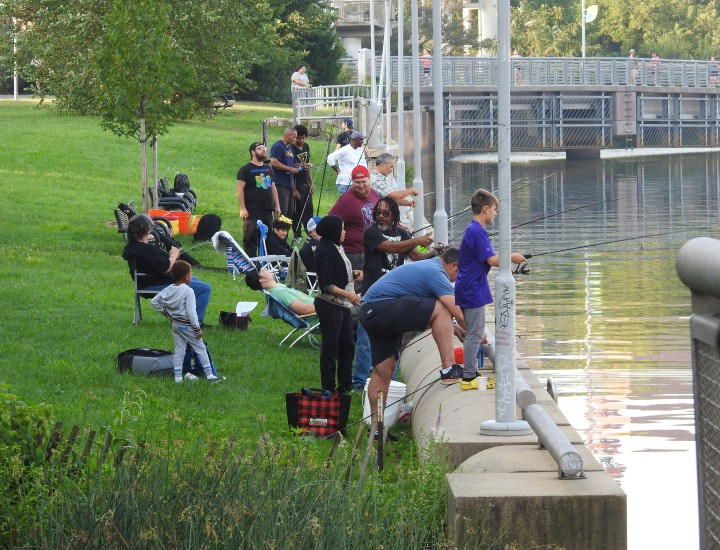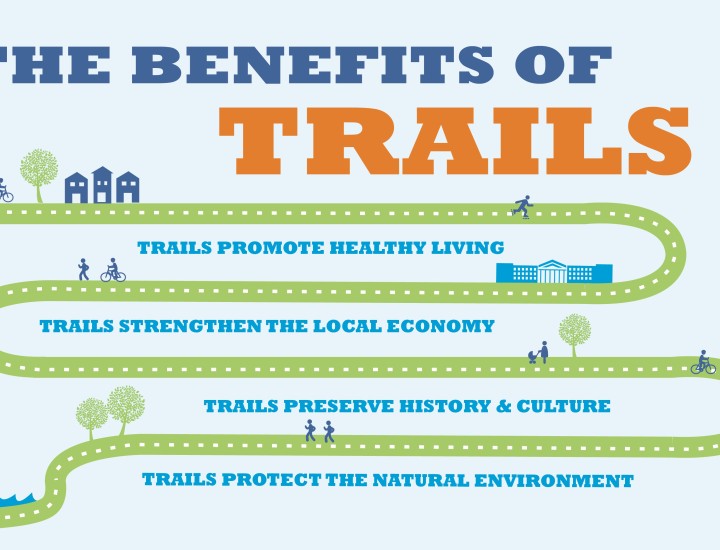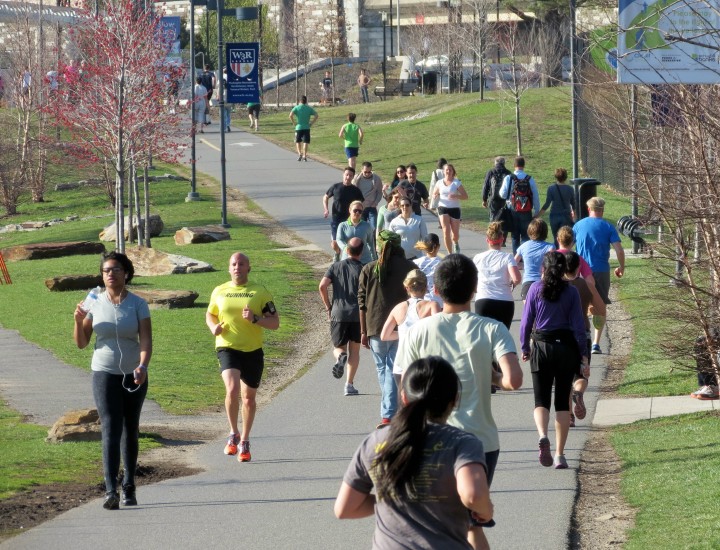The Revival of the Lower Schuylkill

In 1992, when I started on my seemingly quixotic quest to realize the already thirty-year old plan for Schuylkill River Park, it was described by officials at a city agency as “John’s Happy Trails Project”. Nearly a quarter century later, the same City agency, the Philadelphia Industrial Development Corporation (PIDC), made a 180-degree turn and donated land to create Bartram’s Mile in the belief that it would increase the marketability of the remaining parcels they owned to the north and south of Bartram’s Garden, the oldest surviving botanic garden in North America.

Looking south from the Walnut Street Bridge in 1924 (Image Source: Redemption of the Lower Schuylkill) and 2008 (Image Source: John Randolph)
In a way, this quest began with our first apartment as newly marrieds in the Fitler Square neighborhood of Philadelphia, where we arrived in the early 70s. We were attracted by the promise of a future park along the east banks of the Schuylkill, as described in a 1967 master plan created by John Collins of the Delta Group. Eleven years later, a section of this plan was created centering on Spruce Street. However, nothing further happened except for a small expansion of the Community Gardens in 1987. Frustrated, I gathered a group of neighbors to meet with John Collins to figure out how to realize the promise of Schuylkill River Park. During one of those meetings, I met Andrew Moore, then the Director of the City Parks Association, who introduced me to a book that became pivotal.
In 1924, John Frederick Lewis, a prominent maritime lawyer who served on many Philadelphia arts organizations wrote the Redemption of the Lower Schuylkill, subtitled The River As It Was, The River As It Is, The River As It Could Be. He focused on the moral argument that “the health and happiness of the poor are vital to the health and happiness of the rich” and further stated:
Redeeming the Lower Schuylkill from being an open sewer with its dump collecting station, its oil refineries, abattoir, chemical and paint manufactories, and garbage disposal plants, and making it a beautiful river… is a work of social uplift worthy of a second Messiah.
In 1924, when Lewis wrote his book, Philadelphia was still in the midst of the Industrial Age, and no mayor in his right mind would have advocated removing tax-paying industries from the riverbank. Only after manufacturing peaked at the end of World War II and then virtually died, leaving Philadelphia to become part of the Rust Belt, was the opportunity created to re-develop what became known as “brownfield” sites—including the banks of the Schuylkill.
Andrew Moore also introduced me to Terry Samuel, an Inquirer reporter, who wrote about my work in the 1992 article “Dream Revived for a River Park”, which sparked my quest to realize John Collins’ plan for Schuylkill River Park. A lot of people thought I was crazy. NIMBY neighbors were concerned the new park would create opportunities for crime. People couldn’t understand how a rubble-strewn wasteland could become an attraction. No one had enjoyed walking along or swimming in the lower river for a hundred years.
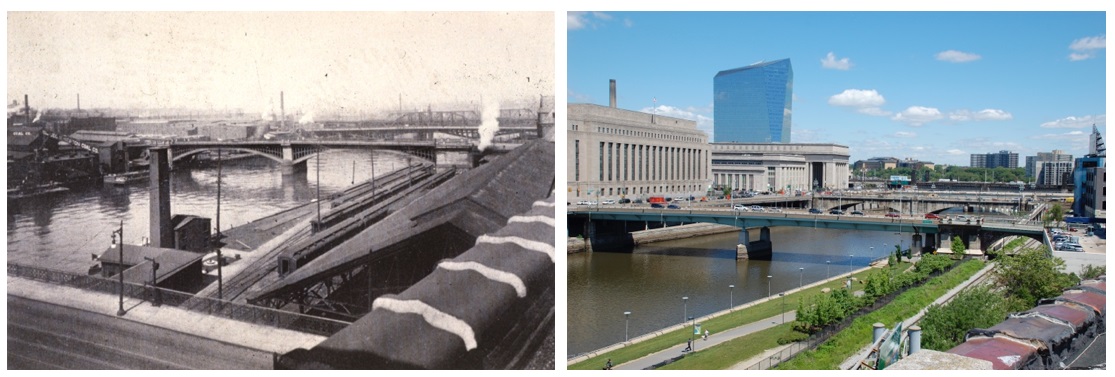
Looking north from the Walnut Street Bridge in 1924 (Image Source: Redemption of the Lower Schuylkill) and 2008 (Image Source: John Randolph)
Since the turn of the century, the lower Schuylkill River has undergone an extraordinary and continuing revival. All this would not have been possible without the convergence of a whole stream of unrelated cultural shifts – most significantly, an appreciation for nature and the river itself, and a new paradigm for a comprehensive transportation system. The city that was once described as “a greene and countrie town” by its founder William Penn in the late 17th century was transformed during the late 19th century and the first half of the 20th century into the Workshop of the World. Today, we are returning to the spirit of Penn’s original vision – focusing on creating life science centers, linear parks and trails that connect diverse communities and creating opportunities for economic development – for a thriving city.
A primary cause was the modern environmental movement, which in the United States began with Rachel Carson, an American marine biologist, writer, and conservationist whose influential 1962 book Silent Spring and other writings are credited with advancing the global environmental movement. Silent Spring sold more than half a million copies in 24 countries.
The movement gained momentum as the evidence of human mishandling of the environment mounted. In early 1969, a massive accident off the coast of Santa Barbara, California poured 100,000 barrels of oil into the Pacific, fouling 35 miles of beaches and killing seabirds, dolphins, sea lions and elephant seals. Public outrage ran so high that President Nixon, a Republican, went to Santa Barbara in March that year to see the cleanup efforts, telling the American public that “the Santa Barbara incident has frankly touched the conscience of the American people.” And then, four months later, in June 1969, chemical contaminants that had been dumped into Cleveland’s Cuyahoga River caught fire.
Also visiting the site of the Santa Barbara oil spill was Wisconsin Senator Gaylord Nelson, who was inspired to create a day devoted to environmental education and awareness. He announced teach-ins on college campuses, which soon grew into a wider movement that swept across the country. The first Earth Day was celebrated on 22 April 1970, attracting some 20 million Americans.
As a result of this growing awareness, the United States passed many pieces of environmental legislation in the 1970s, such as the National Environmental Policy Act (1969), the Environmental Protection Agency (1970), the Clean Air Act (1970) and the Clean Water Act (1972). These remain the foundations of current environmental standards.
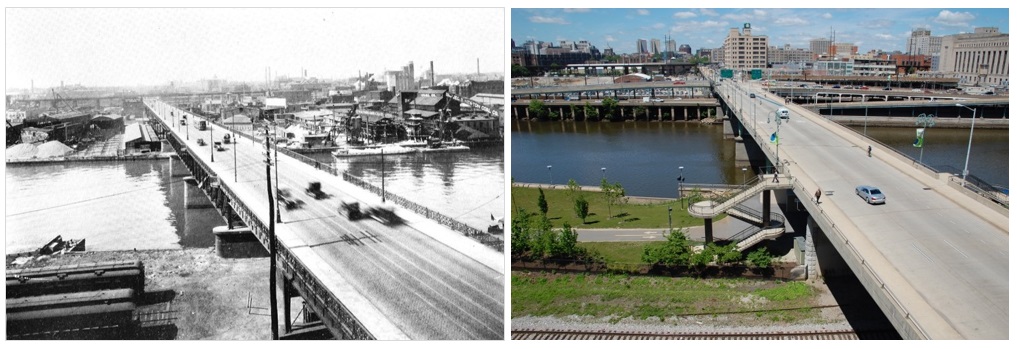
Looking west from the Walnut Street Bridge in 1924 (Image Source: Redemption of the Lower Schuylkill) and 2008 (Image Source: John Randolph)
In addition to being bolstered by the environmental movement, the creation of Schuylkill River Park was facilitated by a major change in national transportation policy that came in 1991, when federal highway policy, which for the previous 35 years had been focused entirely on highways, was expanded to include a more comprehensive view of the transportation system. In that year, President George H.W. Bush signed the Intermodal Surface Transportation Efficiency Act (ISTEA), which authorized $155 billion for highways, highway safety and mass transportation for the next six years. Unlike previous highway bills, ISTEA provided a 10% set aside for ten named “Transportation Enhancements,” one of which was improved facilities for pedestrians and bicyclists. It was this bill that provided early funding for the Schuylkill River Park, which, in order to become eligible for this funding, was renamed the “Schuylkill River Pedestrian and Bike Trail.”
This shift of interest away from highways to trails as part of a comprehensive transportation system, was also championed by the Rails-to-Trails Conservancy (RTC). Starting in 1986, the RTC worked to bring trails to more communities across the country, serving as the national voice for the rail-trail movement. With more than one million grassroots supporters, 24,000+ miles of rail-trails on the ground nationwide and more than 8,000 miles of rail-trails ready to be built, the focus of Conservancy has been on linking these corridors—creating trail networks that connect people and places and bringing transformative benefits to communities all across the country.
Pennsylvania’s open space policy also changed in ways that have supported the transformation of the Schuylkill. The program known as Growing Greener began in 1999 when Governor Tom Ridge and legislative leaders enacted Act 68, which received overwhelming bipartisan support. The bill committed $650 million over five years to preserving farmland, conserving open space, restoring water quality, promoting outdoor recreation and revitalizing communities.
And in Philadelphia, the city was fortunate to have an activist mayor, Ed Rendell, who was elected in 1991 and became a proponent of many development projects, including Schuylkill River Park, which had first been put on the City’s comprehensive plan in 1960 by legendary urban planner Ed Bacon.
Contributing as well to the growing support for the Schuylkill Park was the increasing emphasis that urban planners and theorists of the 1980s and 90s placed on the importance of waterfronts in creating liveliness in modern cities. One hotbed of interest in this was the Waterfront Center, co-founded by Dick Rigby and Ann Breen in 1981 to promote the belief that waterfronts are unique resources. Communities of all sizes transformed abandoned underused waterfront areas for a wide array of new uses, from parks and trails to mixed use and residential projects, as well as industrial activity. Since its formation, the Center has tracked and chronicled the urban waterfront phenomenon as it has grown and spread worldwide, organizing an annual Urban Waterfronts conference on waterfront planning, development and culture.
These and other factors shifted the tide of public opinion in favor of riverfront trails. The stars seemed to align: in 1992, the Schuylkill River Development Council (SRDC) was formed to pursue John Frederick Lewis’ vision, and by 2013, what had once been disparaged as “John’s Happy Trails Project” was appreciated as a tool for economic development as well as for connecting communities together in a manner that promoted diversity, equity and inclusion. In the early 2000s, new major players, including the University of Pennsylvania, Drexel and the Brandywine Realty Trust joined in. They built upon the work started a decade earlier to revive the lower Schuylkill. Jerry Sweeney, President and CEO of Brandywine Realty Trust became President of the SRDC Board of Trustees in 2002, and with that, the original SRDC board, which was largely an assembly of local community organizers, was transformed. Led by the heads of major corporations, universities and City government, it could now support an expanded mission: to create trails and parklands along the entire lower Schuylkill River. The University of Pennsylvania developed the west bank Postal Service parking lots into the 24-acre Penn Park in 2011, Brandywine Realty Trust championed the Schuylkill Yards and built Cira Centre, Cira Centre South and the FMC Tower. In 2012, the redesigned South Street Bridge was opened, incorporating bike lanes and extra-wide handicapped accessible sidewalks and providing a critical connection across the river.
In 2013, PIDC published a master plan for the Lower Schuylkill which included Bartram’s Mile, an extension of the riverfront trail on land donated by PIDC. In 2022, PIDC proclaimed the importance of the Schuylkill River Trail in its Request for a Proposal for the Lower Schuylkill Biotech Campus:
Bartram’s Mile is a new 1.5 mile segment of the Schuylkill River Trail, punctuated by 56th Street Plaza, increasing access to the riverfront and new recreational opportunities for Philadelphians. Upon completion of the Gray ’s Ferry Pedestrian Bridge, this key trail segment will provide a safe and attractive bicycle route between Center City and the LSBC and allow access to one of America’s most comprehensive trail networks, part of more than 750 miles of interconnected trails.
Across the river on the east bank, Hilco Redevelopment Partners (HRP) has launched an historic transformation of the former Philadelphia Energy Solutions refinery into the “Bellwether District.” HRP intends to remediate the polluted site and transform it into a green, sustainable development that features riverside trails and tree-lined byways which will connect Bartram’s Mile and the Schuylkill River Trail upstream with FDR Park at its downstream end.
All this began in 1992 as a quixotic effort to realize Schuylkill River Park from the Fairmount Water Works to Spruce Street. After a decade, the idea became so popular, the project expanded to extend the river trail to the confluence with the Delaware. Today, only two projects now under construction are needed to complete a continuous trail to Bartram’s Garden. As a result of a whole stream of unforeseen forces fortuitously converging, the lower Schuylkill is now being revived. John Frederick Lewis, who envisioned this 100 years ago, would be pleased.
John Randolph is the founder and former president of the Schuylkill River Development Council.
